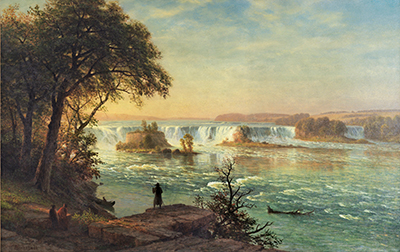The Falls of St Antony, executed between the years 1880 and 1887, is an oil-on-canvas painting by Albert Bierstadt that depicts a waterfall in the Old West as it would have looked before the arrival of European explorers.
Natural landscapes, such as that which is depicted in the painting, were disappearing during the late nineteenth century and the Prussian-born artist expressed his disapproval of the loss of such pristine environments through his paintings. The artwork, measuring 968 mm by 1537 mm and displayed at the Thyssen-Bornemisza Museum in Madrid, can be interpreted as a critique of the destructive forces of industrialization and urbanization.
Three figures, two of which are sitting while the third is standing and looking towards the cascading waters of the Mississippi, are situated on the right-bank of the river. The two seated figures, judging by their attire and headdresses, appear to be Native Americans while the standing figure is wearing European clothing and holding a staff. A fourth figure, also a Native American by appearance, is sitting in a traditional canoe that floats near to the bank of the river. It has been suggested that the European figure represents Louis Hennepin, a Franciscan missionary in the service of the French Crown, who discovered the Falls of Saint Anthony in 1680.
Hennepin, who originated from the Spanish Netherlands, had discovered the Saint Anthony Falls while in the custody of the Dakota tribe and this may explain why the European explorer is accompanied by three Native Americans. The discovery of the waterfall by the Franciscan missionary would lead to its incorporation into the territory of New France and, after the arrival of European settlers, the natural environment would be transformed into an urban landscape. Minneapolis, in the state of Minnesota, developed along the banks of the Mississippi and the Falls of Saint Anthony had become one of the city's landmarks by the time that Bierstadt executed the painting.
Bierstadt, unable to see the Falls of Saint Anthony as they had appeared before the arrival of French colonists, had to rely on his imagination while creating the painting rather than the evidence of his eyes. The artist would have been aware that the unsettled territories in the west would suffer a similar fate as the Falls of Saint Anthony as agriculturalists, industrialists and urbanites continued to migrate westwards. This painting, depicting the waterfall in its primordial state, could be interpreted as a warning that the territorial expansion of the United States would destroy the final scenes of natural beauty on the continent.




